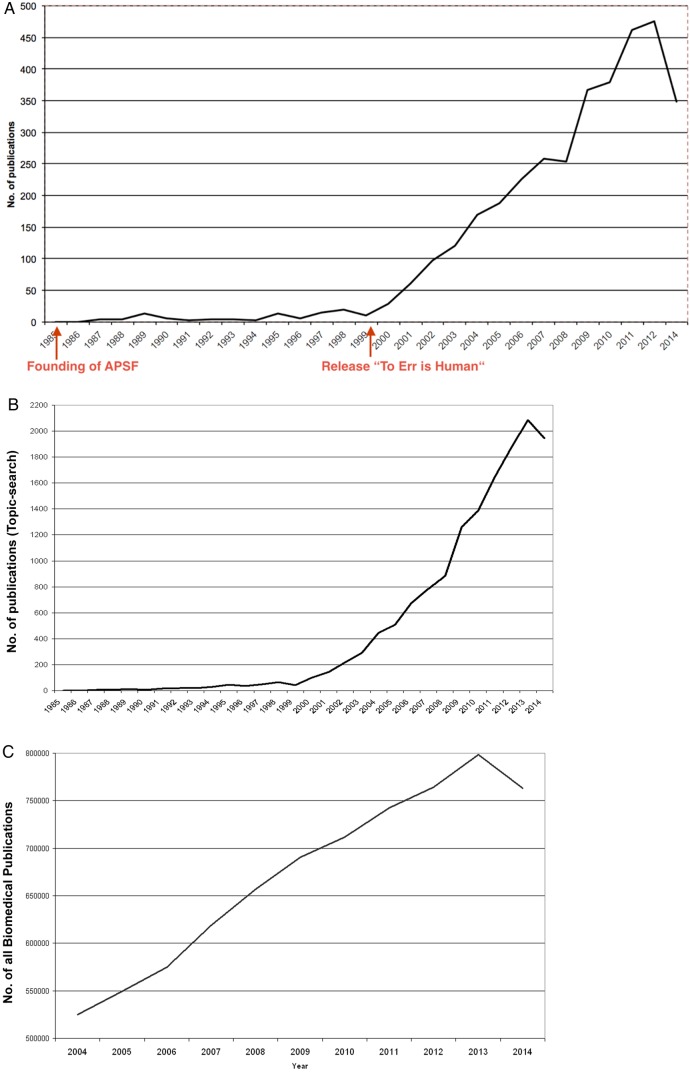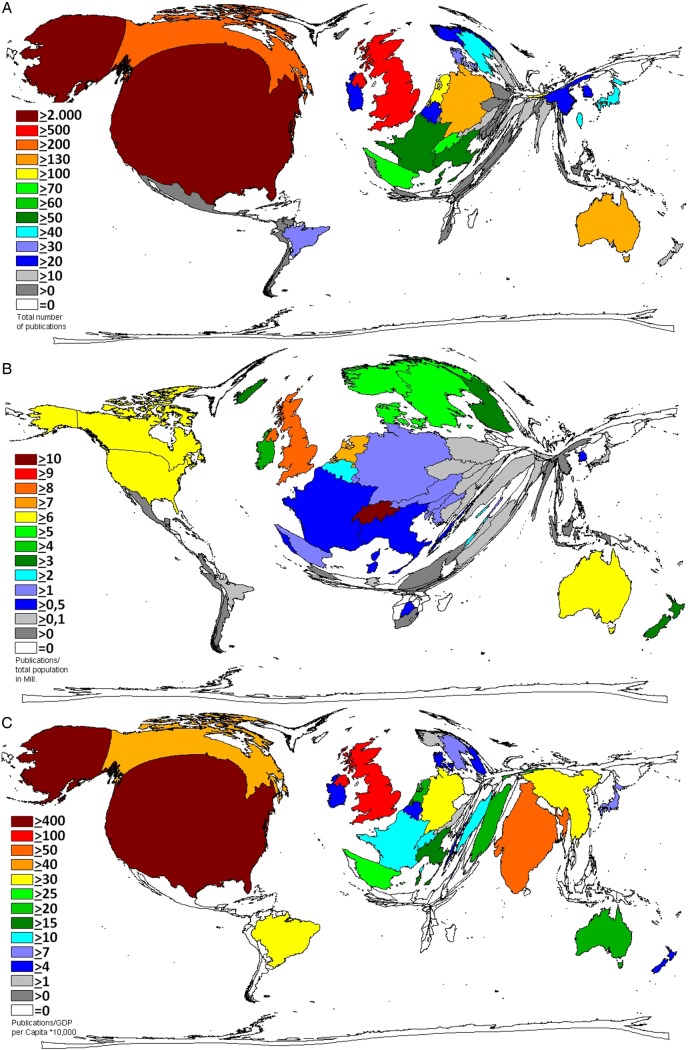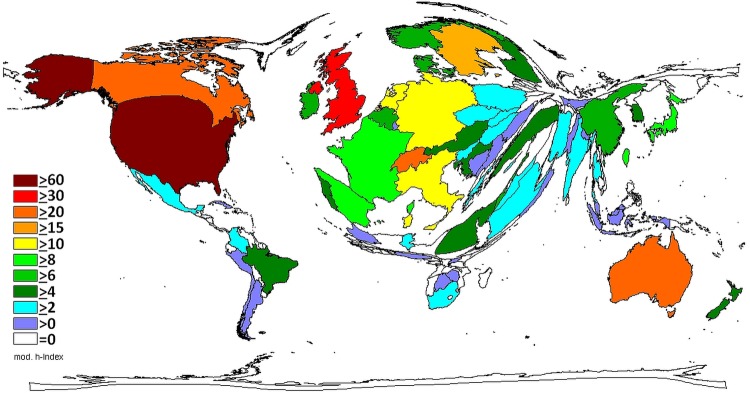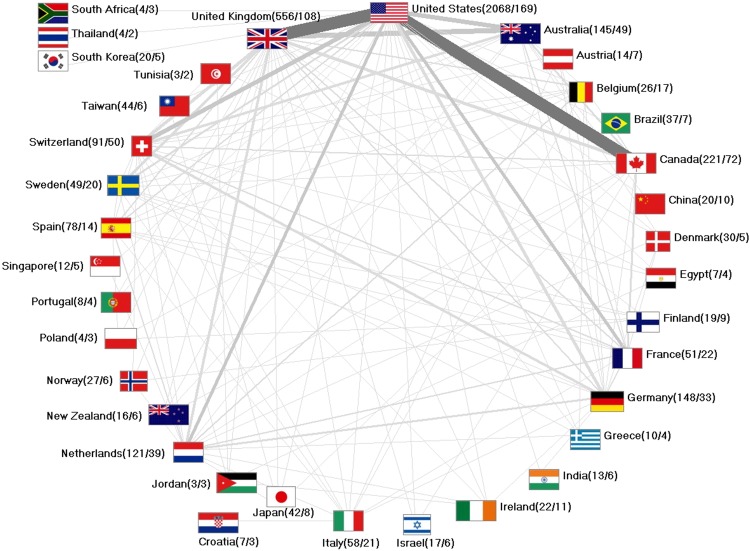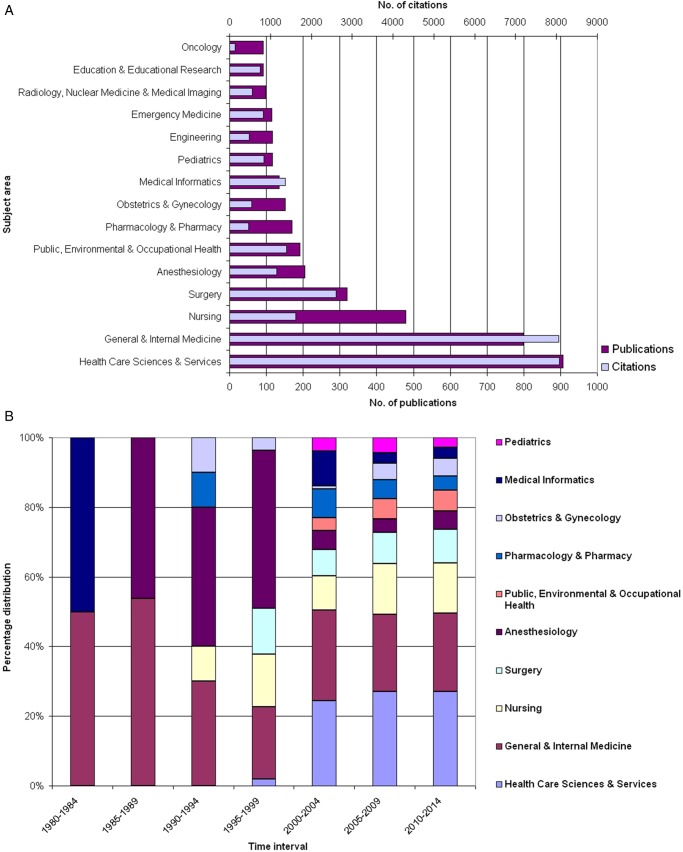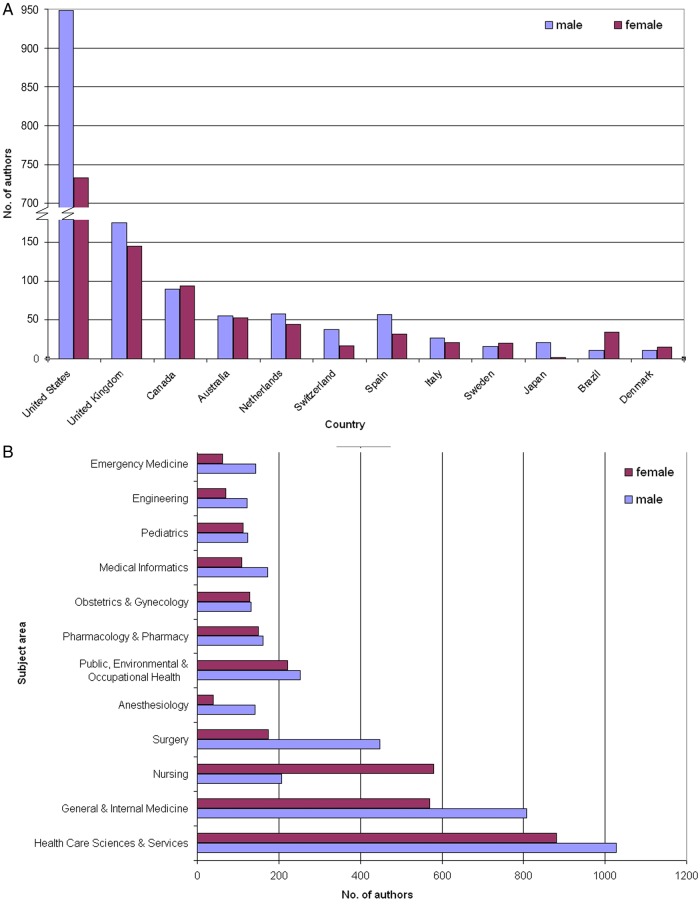Abstract
Objectives
Patient safety is a crucial issue in medicine. Its main objective is to reduce the number of deaths and health damages that are caused by preventable medical errors. To achieve this, it needs better health systems that make mistakes less likely and their effects less detrimental without blaming health workers for failures. Until now, there is no in-depth scientometric analysis on this issue that encompasses the interval between 1963 and 2014. Therefore, the aim of this study is to sketch a landscape of the past global research output on patient safety including the gender distribution of the medical discipline of patient safety by interpreting scientometric parameters. Additionally, respective future trends are to be outlined.
Setting
The Core Collection of the scientific database Web of Science was searched for publications with the search term ‘Patient Safety’ as title word that was focused on the corresponding medical discipline. The resulting data set was analysed by using the methodology implemented by the platform NewQIS. To visualise the geographical landscape, state-of-the-art techniques including density-equalising map projections were applied.
Results
4079 articles on patient safety were identified in the period from 1900 to 2014. Most articles were published in North America, the UK and Australia. In regard to the overall number of publications, the USA is the leading country, while the output ratio to the population of Switzerland was found to exhibit the best performance. With regard to the ratio of the number of publications to the Gross Domestic Product (GDP) per Capita, the USA remains the leading nation but countries like India and China with a low GDP and high population numbers are also profiting.
Conclusions
Though the topic is a global matter, the scientific output on patient safety is centred mainly in industrialised countries.
Keywords: MEDICAL HISTORY
Introduction
The Hippocratic Oath might be the best known medical text from ancient Greek healers. The famous phrase ‘First, do no harm’ might be obvious to a physician today. In fact, the creation of the Oath may have marked the early stages of medical training by requiring strict loyalty to the health of the patient. For the contemporary medical declarations, the Hippocratic Oath can still be taken as a reference.
However, the fact that physicians are obliged not to harm is not a precondition for the safety of their patients. People make mistakes for various reasons. Therefore, the aim of patient safety is to create systems that limit the probability of human failure.1
Just as in 1982, the documentary The Deep Sleep reported a number of up to 6000 preventable deaths or brain damages per year that occur due to medication errors in anaesthesia in the USA.2 Recognising this untenable drawback in 1985, the Anesthesia Patient Safety Foundation (APSF) was founded as a pioneer organisation dedicated to assuring patient safety.3
In 1999, the report To Err is Human by Linda Kohn was published. This report by the US Institute of Medicine stated that in the USA, between 44 000 and 98 000 patients die each year by medical errors that could have been prevented under better conditions.4
Thus, the most important focus of patient safety is to improve the conditions while getting away from a blaming to a safety culture.5 To cast the blame for treatment errors on health workers, even if they turn out to be fatal, is not an adequate approach for prospective optimisation. It is more helpful to analyse the causality of the adverse event. That places the focus on both the cause of the medical mistakes and the procedure to eliminate or at least to reduce the occurrence of it and to elucidate potential protecting factors. Only by understanding why an adverse event occurred is its prevention possible. The systems to be developed should cover both the daily practical work of physicians and the medical teaching. Therefore, patient safety is the general term for a framework which sets standards for learning systems.5
The WHO created guidelines for learning systems. A medical mistake has to be reported and recorded for answering the following questions: What is the incident type? Which influences led to the event? What measures were taken to mitigate the consequences of the error?6 The answers can help to establish a general handling that leads to more safety.
The WHO distinguishes incidents in 11 types: Clinical Administration, Clinical Process/Procedure, Documentation, Healthcare Associated Infection (nosocomial infection), Medication/Intravenous Fluids, Blood/Blood Products, Nutrition, Oxygen/Gas/Vapour, Medical Device/Equipment, Behaviour, Patient Accidents, Infrastructure/Building/Fixtures, Resources/Organisational Management. Therefore, it is obvious that it is not just measurable factors such as medication errors and the quality of medical products that are main parts of learning systems.5 Additionally, the interaction between the behaviour of healthcare workers and the administration of medical facilities is the focus of learning systems to improve patient safety as an ongoing process.5 6
Moreover, current challenges of the medical discipline patient safety are to engage the patients more and more in the treatment procedure for more safety as well as the integration of digital information technology.7 8
Despite the numerous studies that have already been conducted, there is no concise scientometric analysis of the global research architecture so far. Therefore, this study aimed to present an analysis on the research on patient safety in the past 50 years. It leads to an outline of the global research landscape and the analysis of differences and tendencies in the development and the priorities, respectively, of the requirements of the research. A comparison of geographical and social differences leads to statements of regional needs and opportunities (international collaborations). By assessing the gender disparities of the authors in different nations, the question of equal opportunities has been raised.
Methods
Considering the continuing increase of the scientific publication output, the need for assessment methodologies is obvious. This became especially enhanced by the rapid accumulation of scientific online journals for electronic publications.
The applied methodology is a thorough data approach based on the international scientometric platform ‘New Quality and Quantity Indices in Science’ (NewQIS).9
This platform employs and refines scientometric parameters to give distinct information on the scientific output on special research fields and its future trends. Scientometrics deals with the research performances by means of the evaluation of bibliometric issues including the participating authors, institutions, their countries of origin and the number of publications respectively their received citations. Searching the database Web of Science Core Collection (WoS) by Thomson Reuters, the bibliometric information of the scientific works on ‘Patient Safety’ was retraced, processed and analysed. On the basis of these data, it was possible to describe, map and visualise the research outcome with modern techniques like density equalising map projections (DEMP).
Search
To give a coherent summary of scientific productivity, the definition of the search term is an important step in scientometric analysis. There are connected disciplines that are overlapping with patient safety. Topics like nosocomial infections or healthcare-related infections certainly play a major role in the field of patient safety,10 but as described before, patient safety focuses on the prevention of such adverse events by creating safety systems. The special term ‘Patient Safety’ describes a discipline for its own which has been developed steadily since the early 1980s, even though it was already used before.11 Therefore, it was used in the title search of WoS Core Collection with no chronological restriction. Nevertheless, to allow a comparison of the absolute publication numbers, we carried out an additional analysis with the same term in the abstract and the author's keywords in addition. Furthermore, an analysis of the overall output of biomedical studies between 2004 and 2014 was performed to bring the development trends of the study face to face with the scientific publications of the entire field of biomedical research. This was achieved by including the biomedical subject categories in the chronologically limited search.
Evaluation criteria
Beside the total number of publications and their citations, the modified h-index,12 the citation rate and the international collaborations were analysed whereby the country of origin is defined by the specification of author's institutional addresses. In case of the participation of at least two institutions, the publication is considered as a cooperation work.
The global architecture of the research on patient safety was visualised by using DEMPs developed by Gastner and Newman.13 The advantage of this technique is that the worldwide situation can be captured immediately in its entirety by showing the differences via resizing of the country shapes. The calculation of the ratio of the number of publications to the countries’ population as well as to the countries’ GDP per Capita supports the assessment of global landscape, so that it can be interpreted more meaningfully.
The carried out gender analysis puts its focus on both the international differences and the differences between the most assigned subject areas. Since not all the authors’ gender could be determined due to not assignable first names, the validity of this analysis is limited. Hence, a threshold of 50% was set to enhance the expressiveness of the findings. The analysis on the author's gender provides an insight into its global distribution as well as its ratio within the most important subject areas. In the light of the fact that a female scientist's research output still proofed less when considered for publication, the focus on gender aspects nowadays remains absolutely valid.
The analysis of the subject areas allows a visualisation of the shift and diversification of the substantial priorities of patient safety research. Here, Rodrigues et al14 carried out an analysis on patient safety with one focus on the topic clustering based on PubMed categories, whereas the investigated subject areas in this study reflect the WoS original presets. So they are not directly comparable. A productive addition to Rodrigues's work is the analysis of the chronological development of subject areas within patient safety.
Results
Global parameters
The title search was carried out in January 2015 and resulted in 4079 publications on patient safety, while the Topic search provided 14 641 entries by searching the keywords and the abstract additionally.
Between 1960 and 1980 were just a few articles stagnating from 1 to 4 articles per year published on patient safety. In 1963, two articles using the term ‘Patient Safety’ were published. The first time patient safety was used as an own discipline term was in the 1980s. There is a constant stagnating output below five articles per year until 1988. From 1989 to 1999, the output is still below 29 articles per year. From 2000 to 2013, there is a linear increase in articles on patient safety (only in 2008 were there a few less articles). In 2014, the number of articles decreased to 348 from the highest yet reached output of 516 articles in 2013 (figure 1A). The Topic search shows the same trend regarding the increase in the absolute publication numbers only on a respectively higher level. A decrease from 2013 onwards can be stated too. However, the decline is less steep as shown by the Title search (figure 1B). This could be confirmed through the analysis of the biomedical publications in the time frame between 2004 and 2014. Here, the reduction in the absolute numbers of publications from 2013 onwards can also be observed (figure 1C).
Figure 1.
Chronological development of the total number of publications. (A) The Title search of ‘Patient Safety’. (B) The Topic search of ‘Patient Safety’. (C) The Biomedical Research 2004–2014.
Analysing the national number of articles, the USA is the leading country with 2068 publications, nearly four times as much as the UK (556 publications), then are Canada (221 publications), Germany (148 publications) and Australia with 148 publications following (figure 2A). By comparing the national publication output by calculating the ratio of the number of publications and the total population number, another picture can be drawn. The findings show that Switzerland has the best relation. Many of the European Countries are showing a significant increase in country sizes (figure 2B) when compared with the USA. By calculating the ratio of the total number of publications to the Gross Domestic Product (GDP) per Capita, India and China are presented enlarged, due to their large population (figure 2C).
Figure 2.
Publications. (A) Total number of publications per country. (B) Total number of publications in relation to the total population of a country. (C) Total number of publications in relation to the Gross Domestic Product per Capita.
Also, looking at the modified h-index (h), the USA can be singled out with a modified h-index of 63 (figure 3). The UK as the next ranked country can reach half of the value (h=31), following by Canada (h=23) and Switzerland (h=22) (tables 1 and 2).
Figure 3.
Modified h-index.
Table 1.
Ranking of the 10 countries with: (A) the highest absolute article number; (B) the highest modified h-indices
| (A) Country ranking | Article | (B) Country ranking | Modified h-Index* |
|---|---|---|---|
| USA | 2068 | USA | 63 |
| UK | 556 | UK | 31 |
| Canada | 221 | Canada | 23 |
| Germany | 148 | Switzerland | 22 |
| Australia | 145 | Australia | 20 |
| Netherlands | 121 | Sweden | 15 |
| Switzerland | 91 | Netherlands | 13 |
| Spain | 78 | Italy | 11 |
| Italy | 58 | Germany | 11 |
| France | 51 | France | 9 |
*Modified h-Index: only considering the publications found via the search in the WoS Core Collection and applied to the performance of each country.
WoS, Web of Science.
Table 2.
Performance of the countries publishing on patient safety in the order of the number of published items
| Country | Publications | Citations | Citation rate* | h-Index† |
|---|---|---|---|---|
| USA | 2068 | 20 334 | 9.83 | 63 |
| UK | 556 | 4019 | 7.23 | 31 |
| Canada | 221 | 1660 | 7.51 | 23 |
| Germany | 148 | 433 | 2.93 | 11 |
| Australia | 145 | 1016 | 7.01 | 20 |
| Netherlands | 121 | 619 | 5.12 | 13 |
| Switzerland | 91 | 1126 | 12.37 | 22 |
| Spain | 78 | 195 | 2.50 | 8 |
| Italy | 58 | 485 | 8.36 | 11 |
| France | 51 | 254 | 4.98 | 9 |
| Sweden | 49 | 445 | 9.08 | 15 |
| Taiwan | 44 | 161 | 3.66 | 8 |
| Japan | 42 | 131 | 3.12 | 8 |
| Brazil | 37 | 58 | 1.57 | 5 |
| Denmark | 30 | 78 | 2.60 | 7 |
| Norway | 27 | 215 | 7.96 | 7 |
| Belgium | 26 | 231 | 8.88 | 7 |
| Ireland | 22 | 129 | 5.86 | 7 |
| China | 20 | 78 | 3.90 | 6 |
| South Korea | 20 | 48 | 2.40 | 5 |
| Finland | 19 | 121 | 6.37 | 5 |
| Israel | 17 | 158 | 9.29 | 7 |
| New Zealand | 16 | 80 | 5.00 | 5 |
| Iran | 15 | 19 | 1.27 | 3 |
| Austria | 14 | 108 | 7.71 | 4 |
| Turkey | 13 | 39 | 3.00 | 4 |
| India | 13 | 14 | 1.08 | 3 |
| Singapore | 12 | 28 | 2.33 | 4 |
| Greece | 10 | 75 | 7.50 | 3 |
| Saudi Arabia | 9 | 12 | 1.33 | 3 |
| Portugal | 8 | 76 | 9.50 | 5 |
| Croatia | 7 | 31 | 4.43 | 4 |
| Egypt | 7 | 32 | 4.57 | 4 |
| Mexico | 7 | 3 | 0.43 | 2 |
| Lebanon | 5 | 34 | 6.80 | 4 |
| Pakistan | 5 | 0 | 0.00 | 1 |
| Slovenia | 4 | 4 | 1.00 | 3 |
| South Africa | 4 | 27 | 6.75 | 3 |
| Poland | 4 | 74 | 18.50 | 3 |
| Thailand | 4 | 2 | 0.50 | 2 |
| Colombia | 4 | 3 | 0.75 | 2 |
| Jordan | 3 | 30 | 10.00 | 3 |
| Tunisia | 3 | 23 | 7.67 | 2 |
| Cyprus | 3 | 2 | 0.67 | 2 |
| Romania | 3 | 0 | 0.00 | 1 |
| Kazakhstan | 3 | 0 | 0.00 | 1 |
| United Arab Emirates | 2 | 2 | 1.00 | 2 |
| Slovakia | 2 | 2 | 1.00 | 2 |
| Czech Republic | 2 | 6 | 3.00 | 2 |
| Hungary | 2 | 5 | 2.50 | 2 |
| Nigeria | 2 | 0 | 0.00 | 1 |
| Indonesia | 2 | 0 | 0.00 | 1 |
| Argentina | 2 | 0 | 0.00 | 1 |
| Morocco | 2 | 0 | 0.00 | 1 |
| Nepal | 1 | 0 | 0.00 | 1 |
| Chile | 1 | 0 | 0.00 | 1 |
| Serbia | 1 | 0 | 0.00 | 1 |
| Luxembourg | 1 | 0 | 0.00 | 1 |
| Malaysia | 1 | 0 | 0.00 | 1 |
| Cuba | 1 | 0 | 0.00 | 1 |
| Oman | 1 | 0 | 0.00 | 1 |
| Botswana | 1 | 0 | 0.00 | 1 |
| Bosnia and Herzegovina | 1 | 0 | 0.00 | 1 |
| Uganda | 1 | 0 | 0.00 | 1 |
| Peru | 1 | 0 | 0.00 | 1 |
| Zimbabwe | 1 | 0 | 0.00 | 1 |
| Kenya | 1 | 23 | 23.00 | 0 |
| Ethiopia | 1 | 3 | 3.00 | 0 |
| Yemen | 1 | 23 | 23.00 | 0 |
| Iceland | 1 | 20 | 20.00 | 0 |
| Sudan | 1 | 23 | 23.00 | 0 |
| Venezuela | 1 | 3 | 3.00 | 0 |
| Grenada | 1 | 1 | 1.00 | 0 |
| Brunei | 1 | 5 | 5.00 | 0 |
*The calculation of the citation rate with a threshold of at least 30 publications.
†Modified h-Index: only considering the publications found via the search in the WoS Core Collection and applied to the performance of each country.
WoS, Web of Science.
Collaborations
The countries collaborating most are the USA and the UK. They worked together on 60 publications on patient safety. The USA and Canada have a total rate of 57 collaborative articles followed by Australia and the UK with 24 common articles (figure 4).
Figure 4.
International collaborations. Numbers in brackets (number of publications/number of collaboration articles).
Looking at the institutional network, the Harvard University as the most publishing institution is also the central network building facility in the USA with 194 publications that are all drawn up in cooperation. In Switzerland, the WHO is mainly cooperating with the University of Geneva. Joint working groups have formed in the Netherlands and in the UK between universities and health facilities (figure 5).
Figure 5.
Institutional networks. Numbers in brackets (publications/collaboration articles), numbers on the connecting lines (collaboration articles/citations of the collaboration articles).
Subject areas
Analysing the subject areas, it can be shown that within the field of Health Care Sciences & Services and General & Internal Medicine can be found the most publications (906 and 798, respectively) related to patient safety (figure 6A). These papers are also the most cited (ca. 8000 citations). Nursing is ranging third with 479 publications. The chronological development of the distribution of the most assigned subject areas shows that the importance of General & Internal Medicine decreases over time, while the proportion of Health Care Sciences and Services seems currently to be still increasing (figure 6B).
Figure 6.
Subject areas. (A) Number of publications and number of citations of the most applied subject areas. (B) Distribution of the most applied subject areas in different time intervals.
Gender analysis
The analysis of the gender distribution aims at assessment of the current gender equality. So it provides a survey on differences in gender distribution between the countries carrying out research on the topic and subtopics of the medical discipline ‘Patient Safety’.
Globally, there can be found differences in the gender distributions of the publishing authors. USA has a f:m (female:male) ratio of 0.77 that shows a clear dominance of male authors, so that 43% of the authors publishing on ‘Patient Safety’ in the USA are female. The UK has a ratio of 0.83, meaning 45% of the authors are female. Australia and Canada have a nearly equal rate of gender distribution. Japan has the lowest ratio of only 0.09 (0.08% female). The following countries have a higher ratio of female researchers: Sweden (1.25; 55% female), Denmark (1.36; 57% female) and Brazil have an f:m ratio of even 3 (75% female 9 (figure 7). According to this, in Brazil are publishing three times as many female authors on patient safety. Except for the subject area of Nursing, in every other category male researchers are in the majority (figure 4).
Figure 7.
Gender analysis. (A) Gender of the authors of the most publishing countries (thresholds: 30 publications, 30 authors, 50% determined genders). (B) Gender distribution of the most applied subject areas (thresholds: 100 publications, 300 authors, 50% determined genders).
Discussion
Scientometric methods, which have been developed for the NewQIS-Project,9 are to analyse and assess the scientific output geographically as well as chronologically. These methods cannot give an insight into the specific content of the published articles, so the aim of this study is to give a structured scientometric overview of patient safety as a scientific issue. The term ‘Patient Safety’ represents its own healthcare discipline for creating safety systems for healthcare. This term and its significance came up in the 1980s and had made a decisive development to becoming a new healthcare discipline. Therefore, it was necessary to use this specific search term in the publication title.
Another scientometric work on patient safety carried out by Rodrigues et al in 201414 used PubMed as the data source and set a smaller time frame. So the current study can be seen as a more thorough approach and supplement to the findings of Rodrigues. The presented results can provide a more distinct understanding of the global relationships and the value of publication on the discipline of patient safety.
The analysis of the total number of articles per year shows that certain public discussions, especially after the release ‘To Err is Human—Building a safer Health System’ in 1999,4 led to increased scientific interest in the field of patient safety. Since 2012, the number of articles shows a decreasing trend. Also, the comparative analysis via the Topic search and the analysis of the overall biomedical research output reveals a slight decline in the number of articles, albeit as of 2013. It remains to be seen if this tendency continues or if it will be compensated in future observations. Maybe this decline is due to the delay in the availability of the publications because of complex database procedures. Additionally, other aspects of publication principles (expected number of citations) that are crucial to the amount of publications have to be determined. Therefore, adequate study approaches have to be taken into concern.
As shown, the English-speaking countries USA, Canada, UK and Australia are leading regarding the total number of articles and the impact measured by the modified h-index. In contrast, Switzerland is leading regarding the publication/population ratio of the countries. Here, the study shows that the importance of the inclusion of socioeconomic parameters such as the total country population makes the findings more expressive. Switzerland as the headquarter domicile of the WHO is one of the most influential countries regarding patient safety. This can also be confirmed through the analysis of the modified h-indices.
Of course, issues to discuss are the quality and the completeness of the used database. In this respect, it is not possible to capture all publications no matter which database will be searched. The online database PubMed will certainly find more entries, while the Web of Science Core Collection sets its focus on the quality of the listed journals as a result of the higher requirements. Nevertheless, owing to the substantial number of publications and their specific relationship to the study background, it is possible to assess aspects of the research output and their impact on the scientific community by analysing the number of publications and the citations, respectively, the citation indices.15
With respect to the ratio of the number of publications to the GDP per Capita, India and China are striking, certainly due to their huge population.
The USA, Canada and the UK are the main players in the international network that has been developed in respect to the research on patient safety. The Harvard University is the central institution in this network. In 1963, the School of Public Health at the University of Michigan was the first institution to introduce the special term of patient safety to a broader scientific readership. This is reflected by the continuous collaboration with the Harvard University.
Patient safety covers the development of systems for behavioural change in healthcare. These systems can be specific guidelines for surgeries,16 anaesthesia or hygiene for healthcare workers and also guidelines for the verbal and non-verbal communication between healthcare workers and patients.17
As a related but not superimposing topic, ‘nosocomial infections’ does not only refer to the safety of patients and the dangers of infections to healthcare workers but as a major focus on the diverse causes of healthcare-related infections. A comparison on the scientific output of both terms, with a focus on intersecting topic clusters, would be a feasible future study approach.
The analysis of the gender distribution of the publishing authors sets a new focus within the scientometric analyses. However, owing to missing first names and the difficulty in determining some author's gender, it is not possible to define the genders of all authors. In Asian countries, especially, gender-neutral names are very common. Therefore, thresholds were applied to enhance the validity of the findings of the gender analyses. Unlike in previous studies,18 the gender analysis shows no globally uniform picture of the f:m ratio of the scientists working on patient safety. With Japan as a decisive exception, the ratio is more in balance. Some countries (Denmark, Sweden, Canada and Brazil) show even a positive f:m ratio. Considering Nursery as one of the main research fields with a distinct majority of female scientists, this fact is quite comprehensible and explainable.
Conclusions
The origin and causality of adverse events is in the focus of the medical discipline patient safety. Thus, it is a very broad field for scientists all over the world, not least because the medical conditions and education show geographically substantial differences. The access of knowledge and of safer technologies varies significantly in the different regions of the world.
The national scientometric parameters can be interpreted in absolute numbers of publication respectively numbers of citations, but the integration of socioeconomical parameters provides a different geographical picture. Thereby, the application of the national population levels, the GDPs, the expenditures in Research and Development (R&D) and gender equality are important aspects and should be taken in account.19
The findings of this study make clear that the research output does not reflect the real needs of different nations, but can be put on a level with the financial possibilities to investigate in research on patient safety.
The future trend of the development of the total number of patient safety publications has to be monitored to assess the observed slight decrease in this respect.
Acknowledgments
The authors thank C Scutaru and B Kloft for establishing the NEWQIS platform.
Footnotes
Contributors: DAG and DB conceived the idea for this research. MS and DK have participated in the analysis of the data and the evaluation and drafting of the manuscript. MS has written the manuscript. All authors have read and approved the final manuscript.
Funding: This research received no specific grant from any funding agency in the public, commercial or not-for-profit sectors.
Competing interests: None declared.
Provenance and peer review: Not commissioned; externally peer reviewed.
Data sharing statement: No additional data are available.
References
- 1.Sherman H, Castro G, Fletcher M et al. . World Alliance For Patient Safety Drafting Group. Towards an International Classification for Patient Safety: the conceptual framework. Int J Qual Health Care 2009;21:2–8. 10.1093/intqhc/mzn054 [DOI] [PMC free article] [PubMed] [Google Scholar]
- 2.Tomlin J. The Deep Sleep: 6,000 will die or suffer brain damage. WLS-TV Chicago, 1982;20/20.
- 3.PSF. Anesthesia Patient Safety Foundation. About APSF—Pioneer. Saf. http://www.apsf.org/about_safety.php (accessed 30 Jan 2015).
- 4.Kohn L. To err is human: building a safer health system. Washington DC: Nat. Acad. Press, 2000. [PubMed] [Google Scholar]
- 5.World Health Organization. WHO Draft Guidelines for adverse event reporting and learning systems. Vol 16 Geneva, Switzerland: WHO Document Production Services, 2005:80. [Google Scholar]
- 6.World Health Organization. Conceptual framework for the international classification for patien safety. Final Technical Report, 2009;1.1.
- 7.Wolff M, Macias CG, Garcia E et al. . Patient safety training in pediatric emergency medicine: a national survey of program directors. Acad Emerg Med 2014;21:835–8. 10.1111/acem.12418 [DOI] [PubMed] [Google Scholar]
- 8.Tingle J. The WHO patient safety curriculum guide. Br J Nurs 2011;20:1456–7. 10.12968/bjon.2011.20.22.1456 [DOI] [PubMed] [Google Scholar]
- 9.Groneberg-Kloft B, Fischer TC, Quarcoo D et al. . New quality and quantity indices in science (NewQIS): the study protocol of an international project. J Occup Med Toxicol 2009;4:16 10.1186/1745-6673-4-16 [DOI] [PMC free article] [PubMed] [Google Scholar]
- 10.Burke JP. Infection control—a problem for patient safety. N Engl J Med 2003;348:651–6. 10.1056/NEJMhpr020557 [DOI] [PubMed] [Google Scholar]
- 11.Daniels E. Hospital safety and sanitation with special reference to patient safety—Univ-Michigan-Sch-Publ-Hlth. Roy Soc Health J 1963;83:251–1. [Google Scholar]
- 12.Hirsch JE. An index to quantify an individual's scientific research output. Proc Natl Acad Sci USA 2005;102:16569–72. 10.1073/pnas.0507655102 [DOI] [PMC free article] [PubMed] [Google Scholar]
- 13.Gastner MT, Newman ME. From the cover: diffusion-based method for producing density-equalizing maps. Proc Natl Acad Sci USA 2004;101:7499-504. 10.1073/pnas.0400280101 [DOI] [PMC free article] [PubMed] [Google Scholar]
- 14.Rodrigues SP, van Eck NJ, Waltman L et al. . Mapping patient safety: a large-scale literature review using bibliometric visualisation techniques. BMJ Open 2014;4:e004468 10.1136/bmjopen-2013-004468 [DOI] [PMC free article] [PubMed] [Google Scholar]
- 15.Garfield E. Citation analysis as a tool in journal evaluation: journals can be ranked by frequency and impact of citations for science policy studies. Science 1972;178:471–9. 10.1126/science.178.4060.471 [DOI] [PubMed] [Google Scholar]
- 16.Haynes AB, Weiser TG, Berry WR et al. . A surgical safety checklist to reduce morbidity and mortality in a global population. N Engl J Med 2009;360:491–9. 10.1056/NEJMsa0810119 [DOI] [PubMed] [Google Scholar]
- 17.Kripalani S, LeFevre F, Phillips CO et al. . Deficits in communication and information transfer between hospital-based and primary care physicians: implications for patient safety and continuity of care. JAMA 2007;297:831–41. 10.1001/jama.297.8.831 [DOI] [PubMed] [Google Scholar]
- 18.Bundschuh M, Groneberg DA, Klingelhoefer D et al. . Yellow fever disease: density equalizing mapping and gender analysis of international research output. Parasit Vectors 2013;6:331 10.1186/1756-3305-6-331 [DOI] [PMC free article] [PubMed] [Google Scholar]
- 19.Vinkler P. Correlation between the structure of scientific research, scientometric indicators and GDP in EU and non-EU countries. Scientometrics 2008;74:237–54. 10.1007/s11192-008-0215-z [DOI] [Google Scholar]



